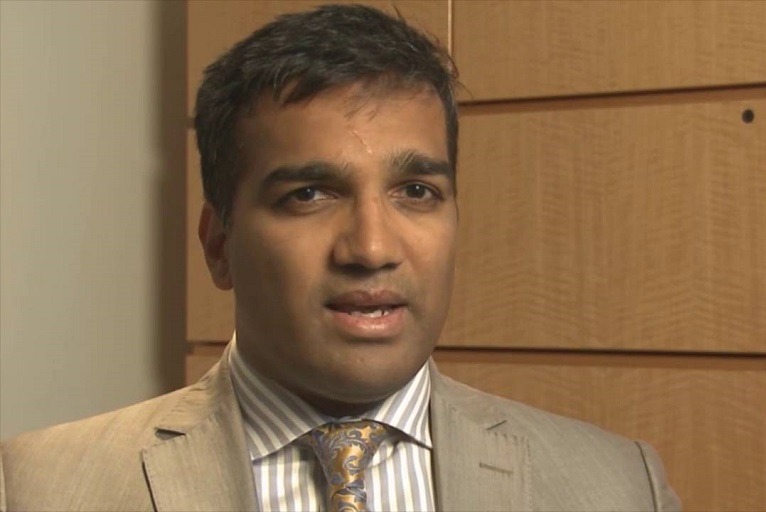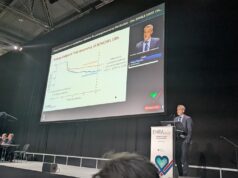
At the AF Symposium 2020 (23–25 January, Washington, DC, USA), Vivek Y Reddy (Helmsley Electrophysiology Center, Icahn School of Medicine at Mount Sinai, New York, USA) reported that pulsed field ablation (PFA)—with the Farawave (Farapulse Inc.) catheter—may be a feasible and safe approach for treating patients with persistent atrial fibrillation (AF). He said that initial results from the PersAFOne study show that the novel technology is not associated with oesophageal lesions and provides “ultra-rapid, safe and acutely effective posterior wall ablation atop of established pulmonary vein isolation”.
In a paper published last year in the Journal of the American College of Cardiology, Reddy and colleagues wrote that PFA is a non-thermal modality “in which ultra-rapid (<1s) electrical fields are applied to target tissue”. They explain that this approach “destabilises cell membranes by forming irreversible nanoscale pores and leakage of cell contents, culminating in cell death”, adding “importantly, various tissues have specific characteristic threshold field strengths that induce necrosis”.
Reddy et al note: “PFA seems uniquely suited for cardiac ablation because cardiomyocytes have among the lowest threshold values of any tissue. This myocardial sensitivity could potentially limit collateral damage of non-target tissue such as the oesophagus and phrenic nerve.” Current ablation technologies (including cryoablation and radiofrequency ablation), according to the authors, have a propensity “to ablate all tissues indiscriminately” and this can lead to complications. The “most feared” of these is atrioesophageal fistula because it is associated with a “mortality exceeding 50%”, they explain.
Reddy et al comment that another potential benefit of PFA is that “unlike other energies, multiple parameters can be fine-tuned with PFA, resulting in different lesion profiles and efficacy”. “It is well-appreciated that the primary mechanism for AF recurrence after conventional ablation procedures is electrical pulmonary vein reconnection over time—because of incomplete lesion transmurality and/or contiguity,” they explain. They add that the first-in-human studies of PFA (IMPULSE AND PEFCAT) show that “PFA preferentially affected myocardial tissue, allowing facile ultra-rapid pulmonary vein isolation with excellent durability and chronic safety” for the management of paroxysmal AF.”
Speaking at the AF Symposium, Reddy called the results of these studies “quite remarkable” but did observe that they only treated a small number of patients. “Question is can we translate some of these successes to [patients with] persistent atrial fibrillation?” he added (at present, no ablative technology is FDA approved for persistent AF). Therefore, the aim of the multicentre, single-arm, PersAFOne feasibility study was to evaluate the safety and efficacy of PFA in patients with persistent AF. The primary safety endpoint was procedure-related events at seven days, and the primary efficacy endpoint was feasibility to achieve acute posterior wall ablation.
In the study, patients with persistent AF underwent pulmonary vein isolation with the catheter and subsequent oesophagogastroduodenoscopy (OED) to assess for damage to the oesophagus. Mapping was also used to determine/perform posterior wall ablation and, in some patients, cavotricuspid isthmus (CTI) ablation was also performed.
As described by Reddy et al in the JACC paper, the 12F over-the-wire Farawave catheter has five splines that each contain four electrodes, and it can be deployed in either a flower petal or basket configuration. In PersAFOne, after pulmonary vein isolation, acute posterior wall ablation (with the catheter) was achieved in all 24 patients included in the study and there were “no safety events”. Specifically, EGD did not find any incidences of oesophageal lesions or immotility (OED in 17 patients; at 3.5±1.8 days post procedure).
A recent animal study, which won best abstract at the AF Symposium and which was also published in Circulation: Arrhythmia and Electrophysiology, provides further evidence that PFA does not cause damage to the oesophagus. Jacob S Koruth (Helmsley Electrophysiology Center, Icahn School of Medicine at Mount Sinai, New York, USA) and colleagues (including Reddy) say “biphasic PFA induced no chronic histopathological oesophageal changes while radiofrequency ablation demonstrated a spectrum of oesophageal lesions including fistula and deep oesophageal ulcers and abscesses”.
Concluding his presentation, Reddy stated his “final thoughts” were that PFA’s “myocardial specificity provides a safety advantage for persistent AF in the context of posterior wall ablation and oesophageal proximity”. “This PFA catheter facilitated ultra-rapid, safe, and acute posterior wall ablation atop established pulmonary vein isolation. Focal PFA is acutely effective for CTI ablation and potentially other targets of ablation,” he added.
However, Reddy noted that there were several limitations with the study. Aside from the need for longer-term safety and efficacy data, he speculated whether PFA would provide “too much ablation”. “With this technology we will be able to do this [provide more complete ablation] very safely, but the question is should we be doing this? I share the view that we may go too far and have to be careful,” he commented.
Medtronic also exploring PFA

Medtronic’s PFA caheter
A few days prior to Reddy’s presentation of PersAFOne at the AF Symposium, Medtronic announced that it had received US Food and Drug Administration (FDA) approval to proceed with an investigational device exemption (IDE) trial to evaluate the safety and effectiveness of its PulseSelect PFA system for paroxysmal or persistent AF. Prior to this approval, in September 2018, the FDA granted the company Breakthrough Device Designation for the technology (for the management of drug-refractory symptomatic AF).
According to a press release, PULSED AF is a prospective multicentre, non-randomised, unblinded worldwide study. Bradley Wilsmore (John Hunter Hospital, New Lambton Heights, Australia) and Atul Verma (Southlake Regional Health Centre, Newmarket, Canada), principal investigator, have already performed the first procedures.
Rebecca Seidel, vice president and general manager in the Atrial Fibrillation Solutions division, which is part of the Cardiac and Vascular Group at Medtronic, comments: “As a global leader in the treatment of cardiac arrhythmias, Medtronic is constantly evaluating new and existing therapies to better meet the needs of patients and the physicians who care for them. The PULSED AF study is another example of our commitment to meaningful innovation and a major step forward in the development of a diverse set of therapy options for AF patients.”












